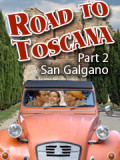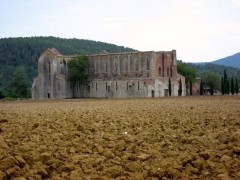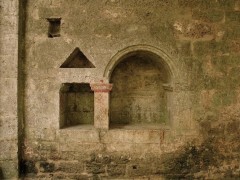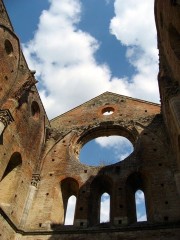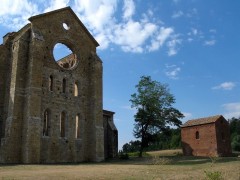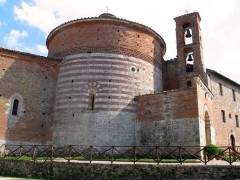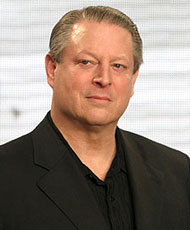“Would you like to visit the ruins of a cathedral today?” Sure I said back to my (Italian) friend, with an image of something Roman in my head. But no, that would be called a temple. Maybe I misunderstood, an abandoned old church perhaps. A cathedral implied a very large ornate structure which certainly piqued my curiosity. “When I went there years ago, sheep and goats were grazing inside … but of course today it is cleaned up as a tourist attraction.” OK, let’s get started!
We left from Florence driving south toward Siena on the Autostrada. It is a rather busy highway and many intriguing sights lie in the distance to encourage us to turn off onto smaller and more interesting roads. But we want to start early at the cathedral in the southernmost area of Tuscany and then work our way back to Florence through the less traveled paths and small towns. Just around Siena, we leave the Autostrada and head farther south through the town of Rosia and we are getting close.
Somewhere around Rosia we got a little “misplaced” and a policeman sitting in a little white car on the shoulder of a country road was asked directions. After a fairly long conversation that included pointing in every direction, giving me the impression that all roads lead to San Galgano, he said “just follow me” and sped off down the winding road. Soon we were going 75mph (well over the speed limit) just trying to keep up with him. As the little white police car went even faster and disappeared around several turns ahead we wondered if this was some form of small town speed trap we were being lured into. But no, at an intersection ahead, he had slowed down just enough to let us see that he was turning right.
By the time we made the turn he was going like a rocket again and we did our best to keep him in sight, reveling in the free-speeding pass we had been given! Between the laughter and the rocking car I couldn’t hold the camera steady to properly document this wild ride. Then he seemed to disappear once and for all. Finally we came upon another intersection. There he was, standing with an official but distinctly casual-Italian posture beside his white police car, as if to say “what took you so long?”. A subtle smile was barely able to conceal the fact that he was having a very good time with this wild ride himself. He simply pointed in the right direction and we were on to the next Tuscan adventure.
We drove into a flat-bottomed river valley and turned left towards a long straight line of trees bordering the access road to the cathedral. There beyond a freshly tilled farm field with great chunks of earth from whose color was derived the familiar pigment name of “raw sienna” was in fact a large 14th century cathedral. How very odd, there are no traces of a large town in the immediate area to support such a monumental construction, just farms and this abandoned cathedral. Apparently it was the medieval villages of Chiusdino and Monticiano along with the proximity to Siena and a route followed by pilgrims and soldiers that gave rise to the building of the cathedral which was started in 1218.
There was no single act of war or nature that served as a demise of the cathedral which was already in serious decline by the mid 1500’s and it is said that by the 17th century only one aged monk still lived within the abbey whose walls were already in ruin. Then in 1786, the bell tower collapsed taking with it, much of the main roof. From that point until the more recent interest as a tourist destination, the architectural components became fair game for local appropriation and use in buildings of the region. Judging by the young age of the Cypress trees along the road leading to the cathedral, a viable interest in tourism to this site has not been occurring for long. The image of sheep grazing throughout the abandoned walls and farmers plowing right up to the foundation while cursing the stray block of stone that fell from the walls in the not so distant past is certainly viable.
On a hill overlooking the ruins of the cathedral stands the first structure of the Cistercian monastic complex for which the cathedral had been intended as the crowning glory, the Rotunda of San Galgano. This structure was completed in 1185 and with renovations in 1924, is in excellent condition today. Along with being a tomb for the saint Galgano Guidotti it contains what is claimed to be an iron sword driven into solid rock in the center of the Rotunda. I remain skeptical of such claims and was not permitted to tug on the corroded saber’s handle to see for myself.The rotunda is reminiscent of the larger Castel Sant’Angelo in Rome and the ceiling of the dome is a most wonderful piece of work. There were some bones on exhibit, presumably what is left of the saint himself, which complimented the rich feeling of mystery this historic site holds.
Despite being promoted for visitation by tourists now instead of barnyard animals, similarities not withstanding, San Galgano is a bit off the major routes and we found it devoid of busses on a warm weekday in September. It was easy to imagine the cathedral in its’ original splendor but the quiet valley made it hard to imagine how numerous the original faithful may have been. Regardless, few things are more appealing to a tourist than the lack of other tourists.
The cathedral of San Galgano is a fairly minor stop on the Tuscan tourist route and large crowds are not to be expected aside from perhaps during the mid-summer months. There is no gift shop (yet) and refreshments are limted but more than adequate. It was a peaceful stroll through a most peculiar historic site and a fruitful stop on our Tuscan Road Trip.
Next stop in The Opinionated Traveler’s Tuscan Road Trip … the walled medieval town, Monteriggioni!

